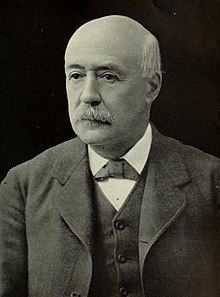Parents Louis Agassiz Name Alexander Agassiz | Children Rodolphe L. Agassiz Died March 27, 1910 | |
 | ||
Born December 17, 1835 ( 1835-12-17 ) Neuchatel Nationality Switzerland, United States Books Revision of the Echini, North American Acalephae, North American Starfishes, Embryology of the Starfish Similar People Louis Agassiz, Elizabeth Cabot Agassiz, Andrew Dickson White | ||
Alexander Agassiz
Alexander Emmanuel Rodolphe Agassiz (December 17, 1835 – March 27, 1910), son of Louis Agassiz and stepson of Elizabeth Cabot Agassiz, was an American scientist and engineer.
Contents

Biography
Agassiz was born in Neuchâtel, Switzerland and immigrated to the United States with his father, Louis, in 1849. He graduated from Harvard University in 1855, subsequently studying engineering and chemistry, and taking the degree of bachelor of science at the Lawrence scientific school of the same institution in 1857; and in 1859 became an assistant in the United States Coast Survey. Thenceforward he became a specialist in marine ichthyology. Agassiz was elected a Fellow of the American Academy of Arts and Sciences in 1862. Up until the summer of 1866, Agassiz worked as an assistant in the museum of natural history that his father founded at Harvard.
E. J. Hulbert, a friend of Agassiz's brother-in-law, Quincy Adams Shaw, had discovered a rich copper lode known as the Calumet conglomerate on the Keweenaw Peninsula in Michigan. Hulbert persuaded them, along with a group of friends, to purchase a controlling interest in the mines, which later became known as the Calumet and Hecla Mining Company based in Calumet, Michigan. That summer, he took a trip to see the mines for himself and he afterwards became treasurer of the enterprise.
Over the winter of 1866 and early 1867, mining operations began to falter, due to the difficulty of extracting copper from the conglomerate. Hulbert had sold his interests in the mines and had moved on to other ventures. But Agassiz refused to give up hope for the mines. He returned to the mines in March 1867, with his wife and young son. At that time, Calumet was a remote settlement, virtually inaccessible during the winter and very far removed from civilization even during the summer. With insufficient supplies at the mines, Agassiz struggled to maintain order, while back in Boston, Shaw was saddled with debt and the collapse of their interests. Shaw obtained financial assistance from John Simpkins, the selling agent for the enterprise to continue operations.
Agassiz continued to live at Calumet, making gradual progress in stabilizing the mining operations, such that he was able to leave the mines under the control of a general manager and return to Boston in 1868 before winter closed navigation. The mines continued to prosper and in May 1871, several mines were consolidated to form the Calumet and Hecla Mining Company with Shaw as its first president. In August 1871, Shaw "retired" to the board of directors and Agassiz became president, a position he held until his death. Until the turn of the century, this company was by far the largest copper producer in the United States, many years producing over half of the total.
Agassiz was a major factor in the mine's continued success and visited the mines twice a year. He innovated by installing a giant engine, known as the Superior, which was able to lift 24 tons of rock from a depth of 1,200 metres (4,000 ft). He also built a railroad and dredged a channel to navigable waters. However, after a time the mines did not require his full-time, year-round, attention and he returned to his interests in natural history at Harvard. Out of his copper fortune, he gave some US$500,000 to Harvard for the museum of comparative zoology and other purposes.
Shortly after the death of his father in 1873, Agassiz acquired a small peninsula in Newport, Rhode Island, which features spectacular views of Narragansett Bay. Here he built a substantial house and a laboratory for use as his summer residence. The house was completed in 1875 and today is known as the Inn at Castle Hill.
In 1875, he surveyed Lake Titicaca, Peru, examined the copper mines of Peru and Chile, and made a collection of Peruvian antiquities for the Museum of Comparative Zoology, of which he was curator from 1874 to 1885. He assisted Charles Wyville Thomson in the examination and classification of the collections of the 1872 Challenger Expedition, and wrote the Review of the Echini (2 vols., 1872–1874) in the reports. Between 1877 and 1880 he took part in the three dredging expeditions of the steamer Blake of the Coast Survey, and presented a full account of them in two volumes (1888).
In 1896 Agassiz visited Fiji and Queensland and inspected the Great Barrier Reef, publishing a paper on the subject in 1898.
Of Agassiz's other writings on marine zoology, most are contained in the bulletins and memoirs of the museum of comparative zoology. However, in 1865, he published with Elizabeth Cary Agassiz, his stepmother, Seaside Studies in Natural History, a work at once exact and stimulating. They also published, in 1871, Marine Animals of Massachusetts Bay.
He received the German Order Pour le Mérite for Science and Arts in August 1902.
Agassiz served as a president of the National Academy of Sciences, which since 1913 has awarded the Alexander Agassiz Medal in his memory. He died in 1910 on board the RMS Adriatic en route to New York from Southampton.
He was the father of three sons – George R. Agassiz (1861–1951), Maximilian Agassiz (1866–1943) and Rodolphe Agassiz (1871–1933).
Legacy
Alexander Agassiz is commemorated in the scientific name of a species of lizard, Anolis agassizi.
